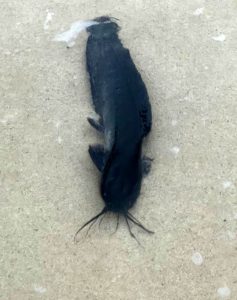
©Craig Thomas
December 10, 2021
When Craig and fellow beach walkers found a black, whiskered fish on Lanikai Beach after last week’s storm, no one knew what it was.
“Susan will know,” a neighbor said.
Susan did not know. When Craig showed me the pictures, and told me that a neighbor got stung when she touched it, I guessed it was some kind of catfish. But the term catfish includes nearly 3,000 species found on every continent except Antarctica. Most are freshwater fish unable to tolerate seawater. A couple of catfish families are considered saltwater fish, but they live mostly in estuaries where salt and fresh water mix.
A group with that many species has widespread traits, but a few stand out. Most catfish have adapted to living in the dark, being active at night and comfortable in cloudy water.
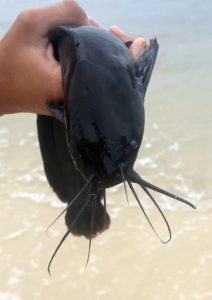
Catfish aren’t blind, but their eyes are small, and vision poor. ©Craig Thomas
Catfish are excellent nocturnal predators, able to follow the wake of a swimming fish by detecting water movement and chemical clues. With such stealth, a catfish can grab a prey from behind. Some catfish species, though, are vegetarians or scavengers, eating only plants or dead animals.
The whiskers on and around most catfish mouths gave the fish their feline name. Contrary to popular belief, however, the whiskers are harmless. Called barbels, these sensory organs are similar to the two whiskers we see on the chins of our native goatfish. Barbels help fish smell, taste, or dig up potential food.
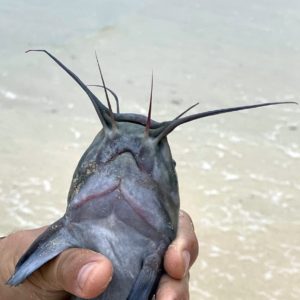
This fish has four pairs of sensory organs called barbels around its mouth. (Not all barbels are visible in this picture.) ©Craig Thomas
The stings catfish are known for come from sharp spines on the fins: one on the leading edge of the back (dorsal) fin and one on each of the two front side fins (pectorals.) Members of our scorpionfish family have similar spines. When threatened by a predator, catfish (and scorpionfish) erect their fins and lock these weapons into place to defend themselves.
Catfish spines contain various venom strengths, creating injuries from mild to severe, depending on the species. Stings can be a puncture, cut, or envenomation. In humans, stings are usually on a hand, the result of removing a catfish from a hook, or in aquaculture farms, from a net. Minor hand wounds are common, and usually heal without treatment. Soaking in hot water may relieve pain. For continued pain, redness and swelling, see a doctor.

Lanikai resident, Luke Kaminskas, a senior STEM student at Le Jardin Academy, knew how to safely handle a Chinese catfish. Luke was not stung while holding the fish for Craig’s photos, but another neighbor experienced a minor sting when she touched the fish. ©Craig Thomas
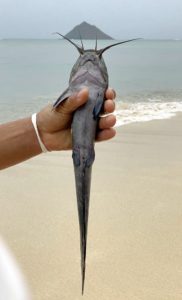
One unusual (and creepy) injury comes from a tiny catfish called candiru, or the toothpick fish. This one-to-two-inch-long catfish anchors itself in the gills of larger fish, where it feeds on blood. Rarely, the candiru swims up, and lodges in, a human urethra. This fish is the stuff of bizarre Internet legends. The occurrence, perhaps an accident on the part of the little fish, has only been documented once in the medical literature, and that in Brazil in 1997. In any case, no worries, skinny dippers. This Amazon River Basin catfish isn’t common there, and has not been introduced elsewhere.
Catfish are farmed throughout Africa, Asia, Europe, and the Americas. One trait that makes catfish desirable as food is that they have few bones. Although they have a backbone and ribs, catfish lack the small bones found in carp and other freshwater fish. Neither do most catfish have sharp teeth.
To reproduce, catfish often spawn in groups, sticking fertilized eggs to plants and gravel. Some guard their eggs and care for their young. One South America native, a favorite in the aquarium trade, is the 2-inch-long Corydorus catfish. The female swallows the male’s sperm, passing his sex cells intact from her gut as she lays her eggs. These, and other catfish species, can breathe air when their water is low in oxygen, and some species can walk across short distances of land.
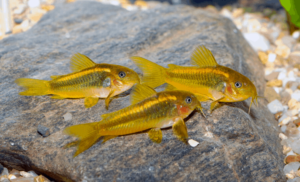
Corydoras catfish females swallow males’ sperm to fertilize their eggs. (Photo of bronze corys from fishkeepingtoday.com)
One common popular species is the bullhead catfish, native to the eastern U.S. Bullheads have been introduced throughout the warm waters of the world as a food fish. Another good-tasting species is the channel catfish, a widespread species native throughout North America. Channel catfish are stocked in Wahiawa’s Lake Wilson.
The common algae scrapers that aquarists call plecos (an abbreviation of their species name plecostomus) are suckermouth armored catfish that can grow to 20 inches long. Because this species gets too big for most aquariums, people often release these pets into Hawaii’s freshwater streams and reservoirs.
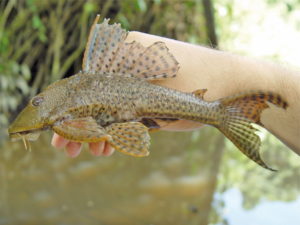
Armored suckermouth catfish, or common pleco, are often sold as algae cleaners for home aquariums. The species is native to northeastern South America. (Photo from Wikipedia)
Chinese catfish, also called Hong Kong catfish, and puntat (Clarius fuscus), were introduced in Hawaii in the 1800s. Today, the species is abundant in streams and reservoirs throughout the islands. The species is distinguished from the channel catfish by its rounded tail.

The Chinese, or Hong Kong, catfish is sometimes on display in aquariums of Chinese restaurants. Hung-Tsun Cheng photo via USGA.gov.
Based on the photos Craig shared with me, I believe what the beach walkers found on Lanikai Beach after the storm were Chinese catfish washed into the ocean from windward canals. Luke said he saw several still in the water.
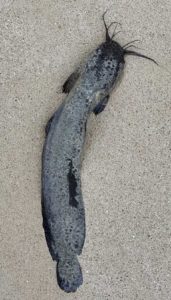
Chinese catfish have rounded tails. Channel catfish tails are forked. ©Craig Thomas
Last week’s Kona storm caused a lot negatives, one being that I missed seeing the beached catfish. (I avoided driving in the storm and stayed in Waialua, where I was when it started raining.) But the storm had one positive affect on me: I learned a whole lot about catfish.
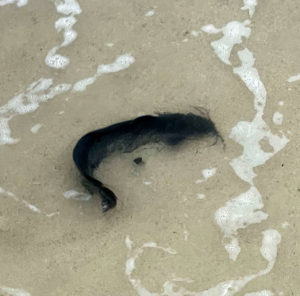
©Craig Thomas